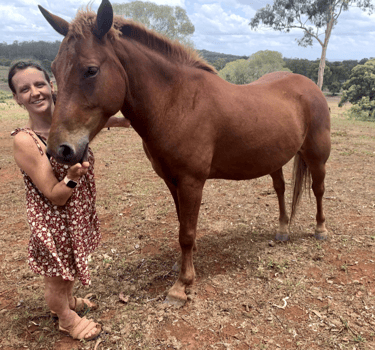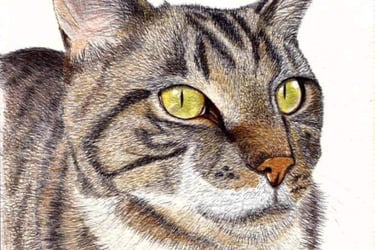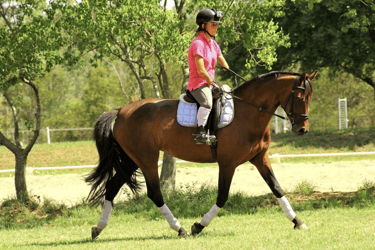‘Brumbies don’t see the wheelchair”
Champion rider Danielle - who is also disabled - tells us what makes Brumbies so valuable.
Keeley Henderson
6/1/20233 min read


Danielle is a talented artist, a champion equestrian and a devoted mum-of-four. She also has a serious disability.
“I have amputations of my left arm and most of my fingers on my right hand, with just my thumb remaining. I’m also missing most of my toes and half of my left foot,” she says.
When she was 14-months-old, Danielle contracted meningococcal disease, a deadly infection which is often fatal. Since then, she’s had over 70 surgeries and has experienced unimaginable pain.
But this incredible mum allows nothing to stand in her way.
When she’s not drawing stunning pet portraits, or homeschooling her kids, Danielle can be found in the paddock.
A passionate horse-trainer, Danielle says Brumbies can be an excellent choice for people who are differently-abled.
“It may take a domestically bred horse a few weeks to get used to a walker or a wheelchair.
“With Brumbies, it usually takes a few moments. They are extremely adaptable and brave horses.
“It's going back to the days of survival of the fittest. If you’re a Brumby who is overly scared or doesn't get along well with others, the chances are you won't reproduce.”
Danielle’s love of horses has helped her through some of her toughest times.
She started riding age eight and was competing by 16.
“Horse riding was the highlight of my life. I would play horses, dream about horses, draw horses.
“They gave me a sense of accomplishment and independence, especially when there wasn't much to look forward to.
“Every time I had surgery, or I was in a wheelchair, it was my goal to recover quickly so that I could get back to riding.”
Danielle won many para dressage - and open - interstate and international competitions.
She even had the Paralympics in her sight
But as she was preparing for the 2016 Rio de Janeiro Paralympics, Danielle discovered she was pregnant.
“I got a positive pregnancy test and thought, 'This is still doable, bubba can just nap in the pram while I ride and I can feed before and after.’”
But fate had other plans
“At the dating scan, we found out there were two babies in there! So my plans changed quite a bit.”
Danielle, who conceived twins naturally, took a break from riding.
To keep her out of trouble, she adopted a wild Brumby.
“I got Reign, a yearling captured with her herd in the VIC Snowy Mountains, in the early stages of my twin pregnancy.
It was a difficult time
“Not only being pregnant with twins, but during the pregnancy, we moved houses three times.
“During times of stress, I would go out and sit with the horses.
“I’d watch Reign, just looking at the way she held herself in the paddock with pure confidence and self-assurance.
It radiated to me.
“As a very young horse, she adapted really well and that gave me the inspiration to get through any struggles in my own life.”
Danielle enjoyed training Reign from scratch.
“Despite her rough start, Reign and all of her herd mates were very easy to halter for the first time and didn't mind human touch.
“I taught Reign to lead, to tie up and when she was old enough, I prepared her and put her first saddle on absolutely problem free.”
When it comes to training horses, tenacious Danielle uses her disability to her advantage.
“The disease affected my growth plates, so I am about the height of an 8-year-old child. This means I can train and educate ponies for children, which adults wouldn't usually be able to ride.”
Today, Danielle’s twins, Lara and Oliver, have just turned seven. Younger brother Dexter is five and Lincon is three.
Brumbies will always hold a special place in her heart
“They seem to have a kind of emotional intelligence that domestically bred horses don't usually have. It's like they know how to listen to you in a different way.
“I have recently sold Reign to a lovely woman who uses a wheelchair.
“Reign had never seen a wheelchair before. When the lady came to meet her, it was awesome how quickly Reign adjusted to her chair and her motorised wheelchair.
“In my experience, most if not all brumbies are very similar. They just take everything in their stride.
“They are truly a very undervalued asset to the Australian people. We are very lucky to have them here with us.”




Acknowledgement of Country
In the spirit of reconciliation, Saving Race acknowledges the Traditional Custodians of country throughout Australia and their connections to land, sea and community. We pay our respect to their Elders past and present and extend that respect to all Aboriginal and Torres Strait Islander peoples today.
Saving Race
Hi, I'm Keeley. I created this blog to spread awareness of how our iconic wild Brumbies have touched the lives of the humans who've saved them.
